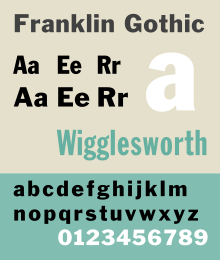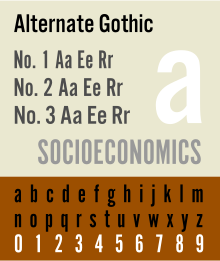Franklin Gothic
 |
|
| Category | Sans-serif |
|---|---|
| Classification | Grotesque |
| Designer(s) | Morris Fuller Benton |
| Foundry | American Type Founders |
| Date released | 1902–1967 |
| Also known as | Gothic #1, Square Gothic Heavy, Gothic #16 |
 |
|
| Category | Sans-serif |
|---|---|
| Classification | realist |
| Designer(s) | Morris Fuller Benton |
| Foundry | American Type Founders |
| Date released | 1903 |
| Re-issuing foundries | Monotype |
| Design based on | Franklin Gothic |
| Also known as | Gothic Condensed (Linotype + Intertype + Ludlow) |
| Category | Sans-serif |
|---|---|
| Classification | realist |
| Designer(s) | Morris Fuller Benton |
| Foundry | American Type Founders |
| Date released | 1907 |
| Design based on | Franklin Gothic |
 |
|
| Category | Sans-serif |
|---|---|
| Classification | realist |
| Designer(s) | Morris Fuller Benton |
| Foundry | American Type Founders |
| Date released | 1908 |
| Design based on | Franklin Gothic |
| Also known as | Trade Gothic (Linotype), Record Gothic (Ludlow), Balto Gothic, (Baltimore Type & Composition Company) |
| Category | Sans-serif |
|---|---|
| Classification | realist |
| Designer(s) | Morris Fuller Benton |
| Foundry | American Type Founders |
| Date released | 1908 |
Franklin Gothic and its related faces are realist sans-serif typefaces originated by Morris Fuller Benton (1872–1948) in 1902. “Gothic” was a contemporary term (now little-used except to describe period designs) meaning sans-serif. Franklin Gothic has been used in many advertisements and headlines in newspapers. The typeface continues to maintain a high profile, appearing in a variety of media from books to billboards. Despite a period of eclipse in the 1930s, after the introduction of European faces like Kabel and Futura, they were re-discovered by American designers in the 1940s and have remained popular ever since.
Franklin Gothic itself is an extra-bold sans-serif type. It draws upon earlier, nineteenth century models, from many of the twenty-three foundries consolidated into American Type Founders in 1892. Historian Alexander Lawson speculated that Franklin Gothic was influenced by Berthold’s Akzidenz-Grotesk types but offered no evidence to support this theory which was later presented as fact by Philip Meggs and Rob Carter. It was named in honor of a prolific American printer, Benjamin Franklin. The faces were issued over a period of ten years, all of which were designed by Benton and issued by A.T.F.
Many years later, the foundry again expanded the line, adding two more variants:
It can be distinguished from other sans serif typefaces by its more traditional double-story a and especially g (as double-story gs are rare in sans-serif fonts), the tail of the Q and the ear of the g. The tail of the Q curls down from the bottom center of the letterform in the book weight and shifts slightly to the right in the bolder fonts.
Barnhart Brothers & Spindler copied the face as Gothic #1, while both Linotype and Intertype, called their copies Gothic #16. Monotype’s copy kept the name Franklin Gothic, but because of the demands of mechanical composition, their version was modified to fit a standard arrangement. The Ludlow version was known as Square Gothic Heavy.
...
Wikipedia
